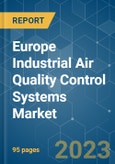The market was negatively impacted by COVID-19. Presently the market has now reached pre-pandemic levels.
Key Highlights
- Over the long term, the European Union's policy on air quality aims to develop and implement appropriate instruments to improve air quality. Consumer awareness, stringent air quality control regulations, and growing end-user industries are major factors driving the market.
- On the other hand, the emergence of alternative and renewable energy sources with reduced/zero emissions and high capital required for installing an air quality control system is expected to hinder the growth of the market studied.
- Nevertheless, retrofitting the existing plants provides tremendous opportunities for European industrial air quality control systems during the forecast period.
- Germany is expected to dominate the market over the forecast period owing to its growing dependence on the industrial sector.
Europe Industrial Air Quality Control Systems Market Trends
Flue Gas Desulfurization (FGD) to Witness Significant Demand
- To reduce the impact of sulfur-based pollutants, industries are implementing several measures and have particularly emphasized gas-phase desulfurization. Hence, flue gas desulfurization (FGD) is the most important technology developed for this purpose.
- The efficiency obtained using scrubbers ranges between 95% and 99% at electricity-generating power plants. Apart from the power plants, the FGD systems are also used in waste-to-energy plants as well, offering efficiency in the range of 95-99%.
- In 2021, the current threshold value for SO2 in Europe is 200 mg/Nm3. Sulfur compounds are removed from the exhaust emissions of fossil-fuelled power plants using a flue gas desulphurization system (FGD). This is accomplished through the addition of absorbents in an industrial process. This has the potential to remove up to 95% of the sulfur dioxide from the flue gas.
- Limestone FGD is the most used FGD process in the world. However, lime or limestone is comparatively less reactive to SO2 removal and, therefore, consumes higher quantities of process water and pumping energy to achieve high circulation rates. This has led to higher operating costs for FGD systems employing lime/limestone.
- Prices of FGD systems have reduced significantly over the years with technological advancements, while the maintenance costs of FGD systems remain high. Therefore, any breakthrough innovation in the servicing sector can open a huge opportunity for players in the sector.
- The thermal power plant is on the way to reach the European Union environmental standards and stabilizing production. The flue gas desulfurization is the most significant ecological project in energy facilities in Southeastern Europe.
- Cities in Poland and Italy are among Europe's worst for air quality. In December 2022, Krako city in Poland had a US AQI of 163. As the air quality will decrease in the future, demand for air quality control systems is expected to increase in the forecast period.
- Therefore, based on the above-mentioned factors, flue gas desulfurization is expected to witness significant demand for the industrial air quality control systems market in Europe over the forecast period.
Germany is Expected to Dominate the Market
- The European Union has been the forerunner in reducing pollution with various initiatives, especially in Germany, which has extremely high targets for implementation. Germany is one of the largest economies in the world and the largest in Europe. Also, there has been considerable growth in Germany's GDP in the past few years. The share of service sectors has been growing over the past few years.
- Also, the country extensively depends on coal for power generation. In 2021, 27.8% of electricity was generated from coal. Due to the growing dependence on the industrial sector and coal-fired power generation, there has been a growth in emissions in the country. To control air pollution, the government has been undertaking measures.
- For instance, the German government approved the German Climate Action Plan 2050. This plan aims to reduce GHG emissions from the energy, building, transportation, industrial, and agricultural industries, by approximately 60%, 65%, 40%, 50%, and 30%, respectively, by 2030.
- Germany aims to cut greenhouse gas emissions (GHG) by 40% by 2020, 55% by 2030, and approximately 95% by 2050. The share of renewables in gross final energy consumption is to rise to 60% by 2050. Renewables are to make up a minimum of 80% of the country's gross power consumption.
- In February 2022, In Berlin, Europe yearly air quality standard value for NO2 of 40µg/m3 was repeatedly exceeded on several important routes with considerable traffic. Road traffic accounted for 75% of emissions causing these exceedances. The speed limit was initially implemented as a trial, along with monitoring NO2 levels (through passive samplers), traffic flow, and speed.
- Hence, owing to such regulations and efforts, the country's demand for air quality control systems is expected to grow during the forecast period.
Europe Industrial Air Quality Control Systems Market Competitor Analysis
The European Industrial Air Quality Control Systems Market is partially fragmented. Some of the key players (not in a particular order) include Thermax Ltd, John Wood Group PLC, Babcock & Wilcox Enterprises Inc., General Electric Company, and Mitsubishi Hitachi Power Systems Ltd.Additional benefits of purchasing the report:
- The market estimate (ME) sheet in Excel format
- 3 months of analyst support
This product will be delivered within 2 business days.
Table of Contents
Companies Mentioned (Partial List)
A selection of companies mentioned in this report includes, but is not limited to:
- Thermax Ltd
- Mitsubishi Hitachi Power Systems Ltd
- John Wood Group PLC
- Babcock & Wilcox Enterprises Inc
- General Electric Company
- PAS Solutions BV
- GEA Group Aktiengesellschaft
- S.A. HAMON
- Horiba Ltd
- Andritz AG
- Calgon Carbon Corporation
Methodology

LOADING...










